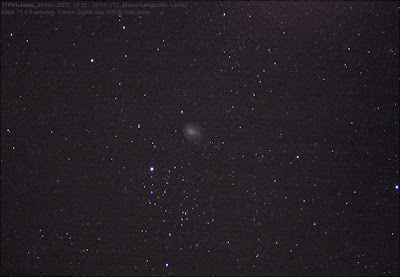Yesterday evening around 21:02 UTC I observed EAS (the
Early Ammonia Servicer, 98-067BA, #31928), the refridgerator-sized tank thrown away from the ISS during the July 23th EVA.
I first picked it up, naked eye, when it passed through northern Ophiuchus at about 50 degrees altitude. It was about mag. +4 to +4.5 at that time. It passed in between Altair and the arrow, and then on to Delphinus, where it rapidly grew fainter.
An attempt to observe the VSSA, another piece of debris jettisoned from ISS the 23th, 10 minutes earlier failed.
The observation was done from a new location. During a bycicle tour with my brother last Tuesday, I explored a part of the open polder to the south-east of my home. In recent years a number of bicycle trails have been constructed there, allowing quick and easy access.
I hit upon a spot some 6.5 km from my home, that seemed promising. No street lanterns for 1.5 km around, and full view down to horizon level a full 360 degrees around. Here's a 360 degree strip panorama I took Friday:
(click image to enlarge)

The trail visible is a footpath that crosses the bird sanctuary here. The landscape is a typical Dutch flat polder landscape. This part of the polder is 1.7 meter below sea level.
On bicycle, I can reach this location in 25 minutes. Which is reasonable enough.
Yesterday evening I checked it out by night. In fact I had planned to do some serious observing at the location, but upon arrival I discovered to my dismay that I had forgotten to put my DCF77 radio-controlled clock in my backpack. So I had no reliable time source with me. Bummer...
After darkness fell, the sky quality turned out to be reasonable. The urbanized west of my country where I live is notably affected by light pollution, even at the few rare spots of countryside like these left. Yet being some 5 km away from the nearest town is obviously better than being in the midst of a town (as Cospar 4353 is).
Around 21:40 UTC, with the sun at -16 degrees altitude, I did a limiting magnitude count in Draco, in the zenith. The first count resulted in +6.5, the second in +6.6. And that is quite good for this part of the country. I could see the milky way down to 35 degrees altitude in the south-southeast.
Light domes dominate the lower parts of the sky though. Worst (and plainly bad) is the northwest, the combined domes of Leiden and the hellishly illuminated Heineken brewery at 2.5 km distance. Alphen a/d Rijn creates a dome in the northeast, and the combined domes of Zoetermeer and The Hague can be seen in the south (the latter were perhaps more prominent last evening than on a normal night, as there was cirrus in this part of the sky). The east and southeast is nice though, and so seemed west.
The location is certainly good enough to do meteor observations and satellite observations. The light pollution in the northwest perhaps makes it not so ideal a spot for Aurora observation, although the north itself is good.
It is very deserted there at night. The only people who have business there at night are the people belonging to the farms in the area. So a good, quiet spot to observe undisturbed, and relatively safe I think.
In the future I plan to do meteor observing sessions here (with satellites as a by-product); and I plan to use this location to track objects of interest that remain too low in the sky for my usual observing location Cospar 4353. For example, future Shuttle MECO-orbit observations (during this part of its orbit, some 20 minutes after launch, the Shuttle and its already decoupled tank pass at about 24 degrees altitude for me). The new secondary location will probably get the designation
Cospar 4354.
I observed the ISS twice that evening: first in deep twilight while biking towards the location, and then around 21:39 UTC when it made a fine zenith pass. The following image shows it in the zenith, near Lyra:
(click image to enlarge)

I made six 10.7 second images during that pass, and stitched them together to show the pass from horizon to horizon:
(click image to enlarge: 4000 pixel wide image!)

While I was biking towards the location in twilight, and close to it, a hare jumped out of the grass aside the bike-lane and ran in front of me for tens of yards. Going back in darkness, another startled hare threw itself in front of my wheels and I had to brake to avoid disaster.






































